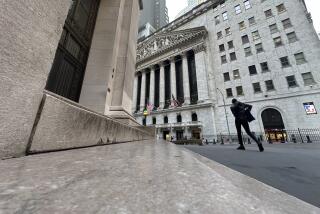Dow tops 12,000 for first time since June 2008
More signs that the U.S. economyâs fourth-quarter momentum has spilled into 2011 are giving stock market bulls a fresh jolt of confidence.
The Dow Jones industrial average on Tuesday closed above 12,000 points for the first time since June 2008 â another milestone in the marketâs rebound from its deep plunge after the financial crisis.
Shaking off the continuing social unrest in the Middle East, the Dow jumped 148.23 points, or 1.2%, to end the session at 12,040.16.
The prospect of revolution in Egypt had sent oil prices surging Friday and triggered a modest global sell-off in stocks.
But on Tuesday equity buyers swarmed again after the Institute for Supply Management said its index of U.S. manufacturing activity nationwide rose in January to the highest level since May 2004.
The index came in at 60.8 compared with analystsâ consensus estimate of 58.0. Any index reading above 50 indicates expansion.
The manufacturing report âranks among the strongest signs to date that the economy is moving into a phase of stronger, sustainable growth,â said David Resler, chief economist at Nomura Securities.
Most U.S. stock indexes Tuesday posted their biggest gains of the new year. The Standard & Poorâs 500 index rose 1.7% and the tech-dominated Nasdaq composite rallied 1.9%.
The Dow now is up 84% from its 12-year low of 6,547 reached in March 2009. Itâs still 15% below its record high of 14,164 set in October 2007.
Stocks had soared in the fourth quarter as economic data improved and as the Federal Reserve pledged to continue pumping money into the financial system to underpin growth.
But many analysts were anxious to see whether consumer and business spending would continue to rise in the new year. The manufacturing data Tuesday, and automakersâ reports of improved retail sales of cars and trucks last month compared with a year earlier, helped boost hopes that the recovery would roll on.
That could give investors more confidence that corporate earnings will continue to grow.
Despite the risks posed by Middle East unrest, many stock investors are taking the view that âwhen the domestic economyâs momentum really starts to kick in, the rest of this stuff doesnât matter,â said Barry Knapp, equity strategist at Barclays Capital in New York.
A pullback in oil prices also buoyed the mood Tuesday. Near-term crude futures in New York fell $1.42 to $90.77 a barrel after reaching a two-year high Monday.
Even before oilâs jump in recent days, rising prices for other commodities had loomed as one of the biggest risks facing the global economy and markets. A surge in grain prices, in particular, in the second half of 2010 fueled inflation in many emerging-market economies.
That triggered credit-tightening moves in recent months by governments of some of the biggest emerging markets, including China, India and Brazil â in turn raising concerns that the global economy would slow and sap U.S. growth as well.
And although U.S. inflation indexes have remained subdued, many companies have warned in their fourth-quarter earnings reports about the higher cost of raw materials.
Brian Bethune, an economist at IHS Global Insight in Lexington, Mass., said one risk was that companies would use commodity-cost pressures âas another excuse to postpone doing any hiring.â
That could further delay meaningful gains in payrolls â the missing link in the U.S. economic recovery. The government will report Friday on January payrolls.
Even if manufacturers add more jobs, the economy faces a drag from the still-depressed housing market and from expected cuts in local government payrolls.
Given those head winds, the Federal Reserve has shown no sign of wanting to follow emerging-market governments in tightening credit. To many investors, that is a green light for the stock market.
Fed Chairman Ben S. Bernanke has repeatedly vowed that the central bank would provide financial stimulus to the economy until the U.S. unemployment rate falls significantly from the current 9.4%.
One side effect of the Fedâs continuing easy-money campaign, while other countries tighten credit or move closer to doing so, is that the dollar has resumed its slide against many other currencies this year. The so-called DXY index of the dollarâs value against six other major currencies fell 0.9% on Tuesday to its lowest level in nearly three months.
But analysts note that a weaker dollar also has been part of the Fedâs strategy to boost U.S. growth: As the dollar falls, it makes U.S. exports cheaper for foreign buyers.
The same is true of other dollar-denominated assets, including U.S. stocks. Anthony Conroy, chief trader at brokerage BNY ConvergEx in New York, said the dollarâs slide is drawing more foreign buyers to American equities.
âThis is an extremely cheap place to put moneyâ for overseas investors, he said.
At the same time, turmoil in Egypt and other emerging markets may be dulling their appeal for U.S. individual investors who have shoveled record sums into those markets over the last decade.
Edward Yardeni, head of investment research firm Yardeni Research in New York, said he was advising that âU.S. and European investors who have been focusing on a âgo globalâ theme should consider a âcome homeâ rebalancing of their portfolioâ to reduce risk.
The Dow now is up 4% this year after rising 11% in 2010. The S&P 500 also is up 4% this year and the Nasdaq index is up 3.7%.
By contrast, the Egyptian stock market is down 18% year to date, India is off 12%, Indonesia is down 7%, Brazil is off 2% and Chinaâs Shanghai composite stock index is flat.
More to Read
Inside the business of entertainment
The Wide Shot brings you news, analysis and insights on everything from streaming wars to production â and what it all means for the future.
You may occasionally receive promotional content from the Los Angeles Times.










